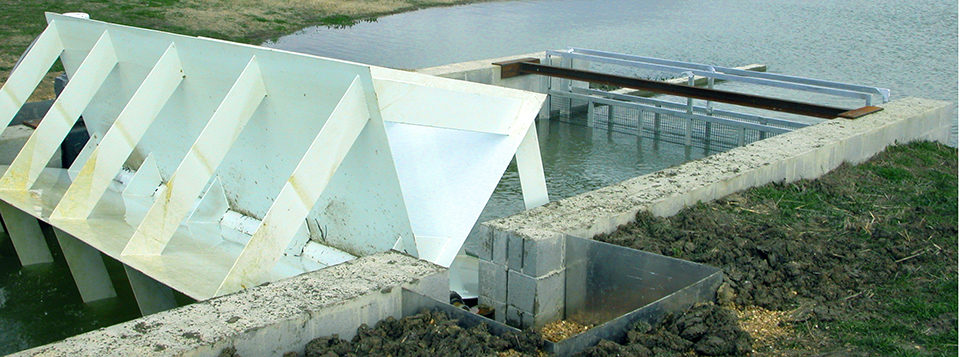Key design parameters based on meeting dissolved oxygen requirements

Channel catfish production in the partitioned aquaculture system (PAS) developed at Clemson University in South Carolina, USA, is greater than in traditional earthen ponds because the PAS provides a better culture environment. Unlike traditional aquaculture, where fish roam freely throughout the pond, the PAS physically separates the fish from the two major pond ecosystem service functions: oxygen production and waste treatment. These functions can then be more easily controlled and optimized.
The PAS consists of a large, shallow algal growth basin that represents about 95 percent of the total system water surface area and a much smaller area where fish are confined at 20 to 40 times the density of traditional ponds. The two areas are linked by water exchange produced by a low-energy paddlewheel pump. After two decades of research, the Clemson PAS represents the ultimate development of a photosynthetic finfish aquaculture system.
Split-pond PAS
Over the past seven years, the authors studied a modified PAS called the split-pond system that takes advantage of the fish confinement benefits of the PAS – facilitation of feeding, inventory, harvest, health management and protection from predators – while minimizing the need for intensive system management.
The split-pond approach has a relatively smaller algal growth basin of about 80 percent of the total area and a larger fish-holding area so that fish are held at only five times the density of traditional ponds. The split pond can be constructed from existing earthen ponds by splitting into two unequal sections with an earthen levee breached with two sluiceways. One sluiceway is fitted with a large paddlewheel that pumps water out of the fish-confinement area. The other sluiceway is for return flow from the algal basin into the fish-confinement area.

D.O. requirements
The key design parameters for the split pond are based on meeting the dissolved-oxygen requirements of the fish. During daylight, water flowing from the algal basin provides oxygen for fish in the confined area. The required flow rate is easily calculated from estimates of the oxygen consumption rate of the confined fish. Paddlewheel size to achieve the desired flow can be determined empirically.
At night, dissolved oxygen cannot be supplied by photosynthesis in the algal basin, so the large paddlewheel is turned off to stop water exchange between the two sections. Dissolved oxygen is then provided by mechanical aerators. Aeration requirements are easily calculated by matching aerator oxygen transfer rates to the fish oxygen consumption rate. Note that water exchange and mechanical aeration never occur at the same time.

Capacity
The split pond at Mississippi State University consists of a 1.42-ha algal basin and 0.40-ha fish-confinement area. The system is designed to hold a maximum fish biomass of approximately 40,000 kg in the confinement area. The algal basin has no fish.
Water flow from the algal basin is approximately 50 m3/minute when the dissolved-oxygen concentration is 5 mg/L. A six-bladed, 3.66-m-long, 2-m-diameter paddlewheel operated at 2.5 rpm produces a water flow of 60 m3/minute, which is more than adequate to provide oxygen to fish during daylight. Nightly aeration in the fish confinement area is provided by two, 7.5-kw paddlewheel aerators.
High production
Through seven years of study, net annual catfish production has ranged from 17,000 to almost 20,000 kg/ha, which is two to four times that achieved in traditional ponds and only marginally less than in the PAS system. At stocking rates of 25,000 fish/ha, fish grow from an average initial weight of 50 to 70 g to 0.80 to 0.90 kg in a seven-month growing season. Feed-conversion ratios are approximately 1.8.
Although daily feeding rates exceed 250 kg/ha for extended periods, total ammonia-nitrogen concentrations seldom exceed 1 mg/L. Much higher total ammonia concentrations are usually seen in traditional ponds at the same feeding rates. The basis for enhanced removal of waste nitrogen in the split pond is unknown.
(Editor’s Note: This article was originally published in the March/April 2010 print edition of the Global Aquaculture Advocate.)
Authors
-
Craig S. Tucker, Ph.D.
National Warmwater Aquaculture Center
Mississippi State University
P. O. Box 197
Stoneville, Mississippi 38776 USA -
Susan K. Kingsbury
National Warmwater Aquaculture Center
Mississippi State University
P. O. Box 197
Stoneville, Mississippi 38776 USA
Tagged With
Related Posts

Innovation & Investment
Aquaculture America 2017: Communication key to the future
This year’s Aquaculture America in San Antonio, Texas, provided significant learning and networking opportunities. It successfully brought together 14 U.S. aquaculture organizations and more than 1,600 participants from Europe, Asia, Africa and Australia.

Responsibility
A look at unit processes in RAS systems
The ability to maintain adequate oxygen levels can be a limiting factor in carrying capacities for RAS. The amount of oxygen required is largely dictated by the feed rate and length of time waste solids remain within the systems.

Health & Welfare
A holistic management approach to EMS
Early Mortality Syndrome has devastated farmed shrimp in Asia and Latin America. With better understanding of the pathogen and the development and improvement of novel strategies, shrimp farmers are now able to better manage the disease.

Responsibility
A look at integrated multi-trophic aquaculture
In integrated multi-trophic aquaculture, farmers combine the cultivation of fed species such as finfish or shrimp with extractive seaweeds, aquatic plants and shellfish and other invertebrates that recapture organic and inorganic particulate nutrients for their growth.


